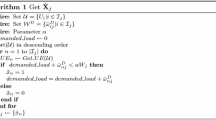Abstract
In this paper an approach for resource management for Heterogeneous Networks (HetNets) based on the dynamic association of users in sets is proposed. The approach is based on the consideration that in a telecommunication network every access point has the property of limited performance, capacity and service potential. Through the definition of two generalized parameters of the servicing cell a characteristic model of the servicing properties of a HetNet access point is developed. An optimization task is defined for a resource management approach with the goal of “providing user service with the required quality of Service while minimizing servicing costs”. The task is solved via the introduction of a modified ADD/DROP heuristic algorithm. A comparison with two other heuristic algorithms is performed showing some of the advantages of the proposed algorithm such as its low computational complexity, fast convergence and effectiveness of the heuristic procedure. A sample application for transmission power control is presented.


Similar content being viewed by others
References
Brown, G. (2007). White paper: Converging telecom & IT in the LTE RAN. http://www.samsung.com/global/business/business-images/resource/whitepaper/2013/02/Converging-Telecom-and-IT-in-the-LTERAN-0.pdf.
Chen, S., & Zhao, J. (2014). The requirements, challenges, and technologies for 5G of terrestrial mobile telecommunication. IEEE Communications Magazine, 52(5), 36–43.
Tsigas, P., & Zhang, Yi. (2001). A simple fast and scalable non-blocking concurrent FIFO queue for shared memory multiprocessor systems. In ACM symposium on parallel algorithms and architectures, July 4-6, Crete Island, Greece.
Nilsson, T., Wikstrand, G., & Eriksson, J. (2007). A collision detection method for multicast transmissions in CSMA/CA networks. Wireless Communications and Mobile Computing, 7(6), 795–808.
European Commission (2010). European programme for critical infrastructure protection http://europa.eu/legislation_summaries/justice_freedom_security/fight_against_terrorism/l33260_en.htm
Reese, J. (2005). Methods for solving the p-median problem: An annotated bibliography. http://ramanujan.math.trinity.edu/tumath/research/reports/report96.pdf
Varnamkhasti, M. J. (2012). Overview of the algorithms for solving the p-median facility location problems. Advanced Studies in Biology, 4(2), 49–55.
Beasley, J. (1985). A note on solving large p-median problems. European Journal of Operational Research, 21(2), 270–273.
Ceselli, A. (2003). Two exact algorithms for the capacitated p-median problem. Quarterly Journal of the Belgian, French and Italian Operations Research Societies, 1(4), 319–340.
Charikar, M., Guha, S., Tardos, ’E., & Shmoys, D. B., (1999). A constant-factor approximation algorithm for the k-median problem. In 31st Annual ACM symposium on theory of computing, May 1-4 (pp. 1–10). Atlanta, Georgia, USA.
Cheriyan, J., & Ravi, R. (1998). Approximation algorithms for network problems. Lecture notes.
Chioua, Yu-Chiun, & Lan, Lawrence W. (2001). Genetic clustering algorithms. European Journal of Operational Research, 135(2), 413–427.
Christofides, N. (1975). Graph theory: An algorithmic approach. New York: Academic Press Inc.
Ceselli, A., & Righini, G. (2005). A branch-and-price algorithm for the capacitated p-median problem. Networks, 45(3), 125–142.
Bozkaya, B., Zhang, J., & Erkut, E. (2004). An efficient genetic algorithm for the \(p\)-median problem. In Z. Drezner & H. Hamacher (Eds.), Facility location: Applications and theory (pp. 179–205). Berlin: Springer.
Captivo, M. E. (1991). Fast primal and dual heuristics for the p-median location problem. European Journal of Operational Research, 52(1), 65–74.
Rardin, R., & Uzoy, R. (2001). Experimental evaluation of heuristic optimization algorithms: A tutorial. Journal of Heuristics, 7(3), 261–304.
Asenov, O., Koleva, P., & Poulkov, V. (2014). Quality improvement of generic services by applying a heuristic approach. In L. Ligthart & R. Prasad (Eds.), Convergence of communications, navigation, sensing and services (pp. 91–125). Aalborg: River Publishers.
Asenov, O., Koleva, P., & Poulkov, V. (2013). Heuristic approach to dynamic uplink power control in LTE. In International conference on telecommunications and signal processing (TSP), July 2–4 (pp. 235–238). Rome, Italy.
Acknowledgments
This work was supported in part by the Grant DDVU02/13 “Public and Private Multimedia Network Throughput Increase by Creating Methods for Assessment, Control and Traffic Optimization” of the Bulgarian Science Fund.
Author information
Authors and Affiliations
Corresponding author
Rights and permissions
About this article
Cite this article
Koleva, P., Poulkov, V. & Asenov, O. Resource Management Based on Dynamic Users Association for Future Heterogeneous Telecommunication Access Infrastructures. Wireless Pers Commun 78, 1595–1611 (2014). https://doi.org/10.1007/s11277-014-1911-z
Published:
Issue Date:
DOI: https://doi.org/10.1007/s11277-014-1911-z




